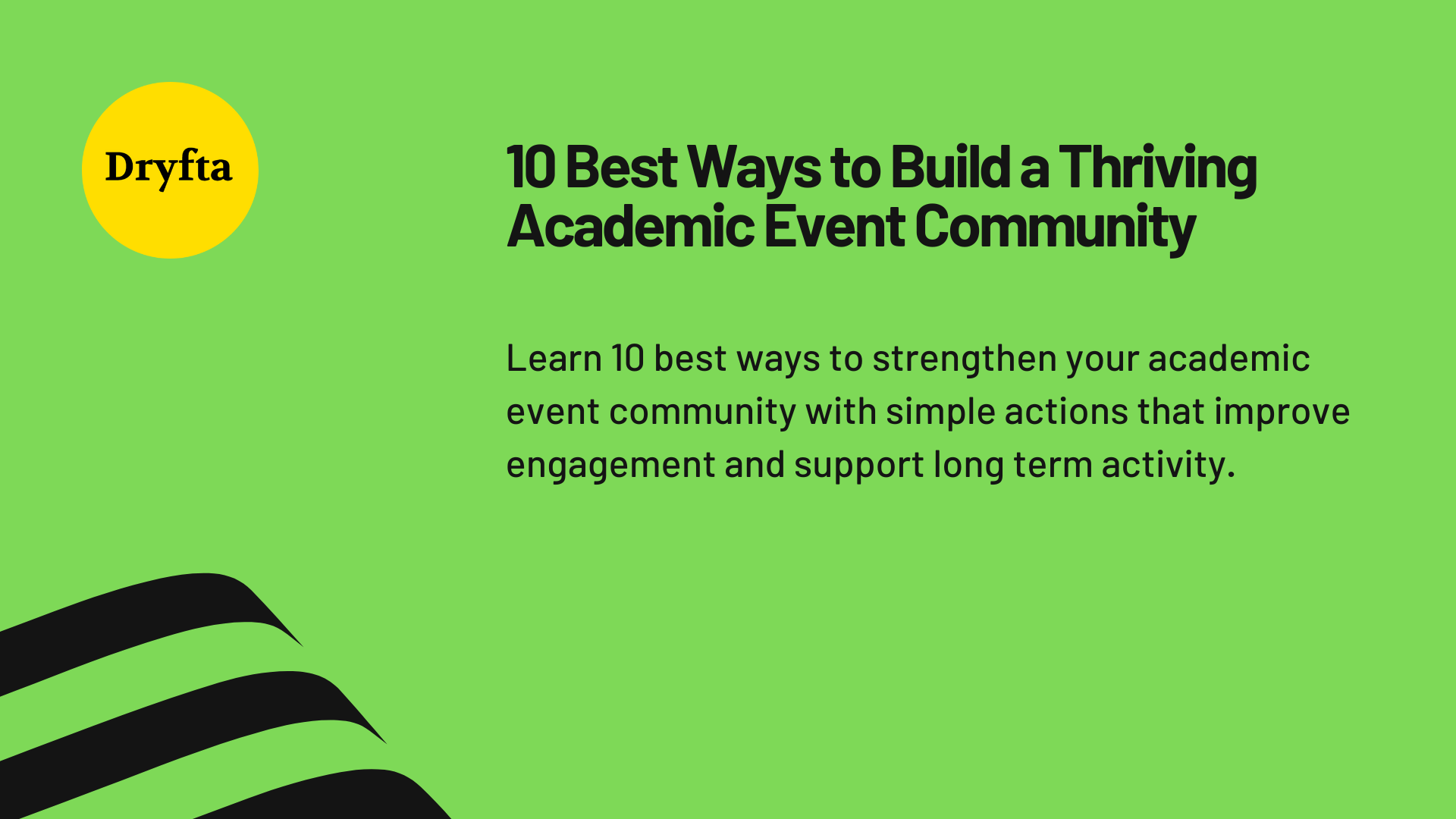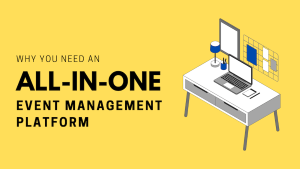
How does an academic event grow from a simple gathering into a strong community you feel part of right away? Academic events bring people together to share ideas and learn. A strong academic event community makes these events even better. It helps its members settle in right away, with clear steps and simple layouts guiding them throughout the process. These practices help the teams maintain order and keep things easy for all users from start to finish.
The community grows when its members feel a sense of belonging to the group, and such a connection is built through shared spaces, simple instructions, and easy access to resources. These elements help members focus on the content rather than spend time searching for basic information.
This guide explains practical steps for building and maintaining a strong academic event community.
1. Define the Purpose of Your Academic Event Community
Strong communities need to have a solid purpose. People join when they know why the community exists and what they can gain from it. Purpose gives direction and helps you plan the right content. Event experts say that clear goals improve long-term engagement.
Share your purpose in easy words that anyone can follow. Explain whether the community will support research, student learning, collaboration, or networking. Keep the purpose visible on your event website and in your email communication.
A clear purpose also helps you design sessions that match your audience. It guides you as you choose topics and activities for future events.
2. Engage Key Stakeholders Early in the Process
Many groups are involved in academic event planning. Students, faculty, reviewers, sponsors, and administrators all take part in these groups. Engaging them early helps the community form faster. It also supports smoother planning.
Ask stakeholders for their input on topics, formats, and schedules. Minor roles, such as session support or content suggestions, help them feel included. This, in turn, will increase their ownership and improve participation. Stakeholders can also help you to identify potential challenges early.
Set up one structured method to track and store contact information from stakeholders. Dryfta’s CRM can support structured communications with stakeholders for events across all groups.
3. Maintain Consistent Branding
Consistent branding helps people recognize your academic event community and builds trust because users see the same style each time. It also keeps things clear for your audience.
Stick to one set of colors, fonts, and layouts across your event site, email communications, and posters. A consistent branding also reduces confusion when you send updates across different channels.
Give your team clear rules on how to use branding. Keep one folder with all approved visuals and templates in it. Match the same tone and style across all communications. A unified branding helps your academic event community maintain a trusted, well-managed look.
4. Offer Simple and Meaningful Engagement Activities
Engagement activities help your academic event community to stay active. People become more involved when they take part in activity sessions rather than just watching quietly. Engage your community with basic tools like polls, Q&A sessions, small groups, and breakout discussions. Most academic events can be designed to accommodate these types of activities.
Give members clear instructions on how to join each activity. Tools should feel simple the moment people open them. Dryfta provides polls, surveys, and session engagement tools that work on web and mobile.
5. Introduce Technology to Support Community Growth
Digital tools help your academic community stay organized and informed, reduce manual work for your team, and ensure members receive the right information at the right time. Go with a set of tools that support registration, email reminders, schedule updates, and feedback. These tools help members follow sessions and stay prepared. Many higher education events choose automated reminders to improve attendance.
Rely on a single platform for as many tasks as possible and ensure it works on mobile devices as well. Many students, professors, and researchers move from classroom to lab to office. Therefore, access to mobile apps helps them stay connected to event news. Dryfta supports registration, websites, and attendee tools in one place.
6. Collect Feedback from Your Community and Improve Frequently
Feedback helps you understand what your academic community needs by pointing out what works well and what needs to change. Send simple surveys after each session. Ask clear and short questions so members can answer quickly. Many higher education events prefer short forms because they give valuable information and take little time to complete.
Review the responses as soon as possible and look for repeated comments, since these patterns show what you should adjust for the next event. Clear feedback supports better planning and helps you make the right decisions.
Tell your community about the changes you’ve made and share a brief update in your email or on your website. Acting on feedback shows your community that their opinion is respected and motivates others to join in.
7. Promote Inclusivity and Accessibility
Creating an inclusive environment will make each member feel valued in your academic event community. It ensures that different groups can take part without any barriers. Many higher education institutions treat inclusivity as a core part of event planning. Build your event pages with clear layouts, readable fonts, and high contrast colors. These design steps help people with different visual needs. They also allow users to read information quickly on screens.
Add captions in video recordings or other recorded meetings, as they help people with hearing difficulties and non-native English speakers better understand the content being presented. In addition to offering accessibility options, consider allowing members to attend your events on multiple platforms (such as hybrid or virtual)to enable attendance for those unable to attend in person.
8. Build Alumni and Peer Networks
Alumni and peer networks help your academic event community stay active after the event, keeping it strong as members stay connected. Many institutions involve alumni groups to strengthen academic communities over time.
Set up easy-to-access spaces where people can stay in touch. It could be an online group, a small forum, or a discussion page on your event website. Offer structured activities and send simple updates to alumni and peer groups. Regular messages help members to stay connected and be aware of future opportunities.
As a group, encourage the alumni network to share resources, ideas, and new opportunities among themselves. When people share their ideas, it gives everyone a sense of value and brings members back to future events.
9. Measure Your Community’s Impact and Share Results
Measuring impact helps you understand how your academic event community is growing. It provides clear information on participation, engagement, and activity levels for each event cycle. Collect metrics such as return attendees, session ratings, and engagement levels. These metrics show how well your community is thriving.
Compare data across many events to identify changes in attendance and participation and determine whether your community is growing. Maintain accurate, reliable records of the collected data to measure your growth and development on an ongoing basis.
Sharing the information about how thriving your community has been with its membership highlights the value that you bring to the table. Clear reports help people see the impact they make, which supports your efforts to secure funding or assistance.
10. Reward Members and Validate Value
Give members small rewards to recognize their time and effort, using certificates, badges, or thank-you messages to show that their role in the community matters. Share session highlights and/or summary reports with members to clarify and help them understand what benefits they received by participating in the event. Short summaries are a great way to make the educational experience faster and easier for students in an academic environment.
Final Thoughts
A thriving academic event community grows when people feel involved and informed. Clear goals, steady communication, and inclusive design give everyone a place in the group. With early planning and easy tools, teams can handle tasks smoothly while members know what to do at each stage.
Simple engagement actions help people connect. When members take part in small activities, they form links with others who share similar interests. These moments spark connection and help participation stay strong over time.
Dryfta gives event teams a single place to manage their entire academic event cycle. It supports registration, schedules, websites, and communication in a single system. That way, organizers spend less time digging through files and more time on planning the event. Members also get a clear, simple path to follow, which allows them to join sessions and find updates without confusion.
Dryfta also offers tools that support engagement and access. You get built-in features like polls, Q&A, feedback forms, and attendee profiles. These tools help your members participate in sessions and stay connected throughout the event.




